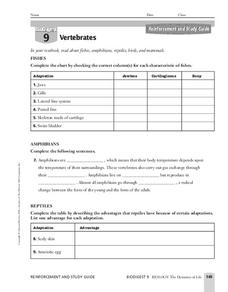Curated OER
Reptile and Amphibian Anatomy
Students identify and interpret the various differences between reptiles and amphibians. Then they draw an amphibian and reptile and correctly label their body parts. Students also invent new reptiles and amphibians, sketch how they...
Curated OER
Animals Around the World
Students study different kinds of animals and what group they belong to. In this animal classification lesson students view different animals and sort them by what group they belong to, for example a snake is in the reptile group.
Curated OER
Alphabetize Reptile Words
In this alphabetize reptile words worksheet, students use the word bank on the page to put eleven words about reptiles into alphabetical order.
Curated OER
Reptiles Vocabulary Multiple Choice Activity
In this reptiles vocabulary instructional activity, students complete a ten question multiple choice activity pertaining to reptiles. Students read the questions and choose the correct answer from four choices.
Curated OER
Reptiles Vocabulary
In this reptiles instructional activity, students read 11 definitions and match them to the correct vocabulary words in a word box. Students write the reptile vocabulary words in front of each definition.
Curated OER
Animals
Students become familiar with the need for categorizing scientific information, in this case, animals. They categorize the 5 groups of animals in a collage and answer questions about each.
Curated OER
What Do You Know About Reptiles?
Introduce reptiles to your class. Each slide provides a list of basic characteristics of snakes, lizards, crocodilians, turtles, tortoises, and tuataras. The last slide provides learners with the titles of a few books they can read if...
Curated OER
Fossils
In this earth science worksheet, students use the clues given at the bottom of the sheet to solve the crossword puzzle on fossils. They identify specific names of fossils and how to make a mold of one.
Curated OER
Prairie Scales and Prairie Smoothies
Sixth graders explore the animals that live on the prairie and identify differences between amphibians and reptiles and the adaptations each have made to live on the prairie.
Curated OER
Animal Classification
Second graders identify characteristics of and group animals by the five categories of vertebrates.
Curated OER
Mapping Where Animals Live
What type of reptiles live in New York State? This instructional activity gets the class thinking about what factors determine where particular animals live. They analyze the Hudson Valley environment, identify specific reptile and...
Curated OER
Describing Animals
While a short review of animals and their classifications, this could be useful when discussing this topic in the classroom. There is a list of questions at the end to help review the main ideas. Reptiles, amphibians, and mammals are...
Curated OER
Reptiles
For this reptiles worksheet, students identify and label the different parts of reptiles. They complete 10 short answer questions after reading the information provided in the worksheet.
Curated OER
Sunken Millions Animals
This PowerPoint includes a game with ocean graphics in which two teams answer increasingly difficult questions about animals. Topics covered include plant and animal cells, animal adaptation, and similarities and differences between...
Curated OER
Reptiles and Amphibians
Fourth graders explore biology by viewing animal videos in class. In this amphibian and reptile lesson plan, 4th graders identify the key differences between reptiles, amphibians and other animal classifications. Students view video...
Curated OER
Cool It
Students simulate lizard temperature regulation. In this Science lesson, students use a thermometer as a pretend lizard. Students must keep their lizard within a particular temperature range while moving through a specified course.
Curated OER
Plants and Animals
Students find common needs between plants and animals. In this plants and animals lesson students compare that both plants and animals need food and water. They also find the differences between plant and animal needs.
Curated OER
Reptiles and Amphibians (1)
In this animals activity, students practice decoding the names of 14 different types of reptiles and amphibians. Students write their answers on the lines provided on the activity.
Curated OER
Vertebrates
In this vertebrate instructional activity, students review the different adaptations for the 5 groups of vertebrates: birds, mammals, reptiles, amphibians, and fishes. This instructional activity has 12 matching, 1 fill in the blank, and...
Curated OER
Name Scramble
In this name scramble worksheet, students practice unscrambling the names of ten reptiles and amphibians for spelling mastery of these animals.
Curated OER
Reptiles
In this word search worksheet, students locate ten reptiles. The word list includes tortoise, boa, skink, alligator, and turtle.
Curated OER
Small Pond Creatures
Learners complete a unit about the different creatures that can live in a small pond habitat. They create a glossary, create a class Small Pond mural, develop a Frog Fact File, read a variety of books, and conduct research for a report...
Curated OER
What Makes a Dinosaur a Dinosaur?
Students explore dinosaur stance and the dinosaur-bird connection. They investigate what distinguishes dinosaurs from other reptiles? Students discuss how dinosaurs stand their legs positioned directly under their bodies. They are...

























